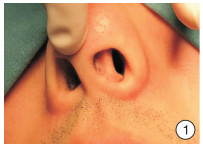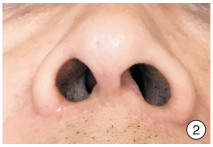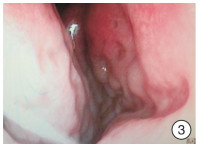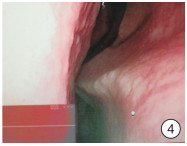The clinic research of septoplasty according to different types of nasal septal deviation
-
摘要: 目的 将鼻内镜下观察到的鼻中隔偏曲部位划分为不同的偏曲单元,根据偏曲单元进行分型,并针对不同的偏曲类型采用个体化的鼻中隔矫正手术。 方法 选取120例行鼻中隔矫正术的患者,在排除手术禁忌后,所有患者术前均按研究者制定的鼻中隔偏曲单元进行分型,并根据不同鼻中隔偏曲类型进行个体化鼻中隔矫正术。 结果 针对不同鼻中隔偏曲类型,实施个体化鼻中隔矫正术后,所有患者术后鼻塞症状均较术前得到不同程度改善。 结论 采用以偏曲单元为基础的鼻中隔偏曲分型法,并以此进行分型来实施个体化鼻中隔矫正手术,效果良好,对临床有重要的实践指导意义,值得推广。Abstract: Objective To divide the deviation parts of nasal septal into different deviation units, and then classify them according to the the deviation units through nasal endoscope, and carry out individual septoplasty for the deviation types. Method One hundred and twenty patients having operation indication with different types of nasal septal deviation according to the standard designed by the researchers were included. All included patients underwent individual septoplasty. Result All included patients, symptoms of nasal obstruction had different degree of improvements after the individual surgery according to the different types of nasal septal deviation. Conclusion Using the classification of nasal septal deviation based on the deviation units, physicians can implement individual septoplasty for patients, which has great guidance to clinical practice. The study has got great results in practice, and deserved extending.
-
Key words:
- deviation of nasal septal /
- nasal septum correction /
- operative
-

-
表 1 术前1周、术后3个月及术后6个月患者VAS评分及鼻阻力平均值比较
Pa/(cm3·s) 时间 VAS评分/分 鼻阻力 偏曲侧吸气时 偏曲侧呼气时 宽敞侧吸气时 宽敞侧呼气时 吸气总鼻阻力 呼气总鼻阻力 术前1周 6.60±1.02 3.98±0.87 2.30±1.01 0.88±0.27 0.83±0.28 0.43±0.20 0.39±0.15 术后3个月 2.83±0.09 0.56±0.67 0.76±0.87 0.78±0.33 0.77±0.35 0.28±0.30 0.27±0.09 术后6个月 2.79±1.09 0.45±0.56 0.86±0.46 0.74±0.45 0.63±0.25 0.30±0.28 0.26±0.12 表 2 术前1周,术后3个月及6个月的NOSE评分
偏曲类型 例数(%) NOSE评分/分 术前1周 术后3个月 术后6个月 Ⅰ 15(12.5) 14.1±1.5 12.4±1.5 12.5±1.3 Ⅱ 75(62.5) 17.8±1.3 8.2±1.4 7.8±0.6 Ⅲ 20(16.7) 16.6±2.0 9.8±1.5 10.0±1.3 Ⅳ 10(8.30) 18.6±1.2 11.5±1.5 10.8±1.6 -
[1] Bateman ND, Woolford TJ. Informed consent for septal surgery: the evidence-base[J]. J Laryngol Otol, 2003, 117(3): 186-189. doi: 10.1258/002221503321192476
[2] 陈凯, 王君, 唐玥玓. 鼻畸形矫正同期鼻中隔偏曲矫正术治疗严重外伤性鼻畸形一例[J]. 山东大学耳鼻喉眼学报, 2020, 34(1): 121-124. https://www.cnki.com.cn/Article/CJFDTOTAL-SDYU202001026.htm
[3] Lin JK, Wheatley FC, Handwerker J, et al. Analyzing nasal septal deviations to develop a new classification system: a computed tomography study using MATLAB and OsiriX[J]. JAMA Facial Plast Surg, 2014, 16(3): 183-187. doi: 10.1001/jamafacial.2013.2480
[4] Mladina R, Skitarelić N, Poje G, et al. Clinical Implications of Nasal Septal Deformities[J]. Balkan Med J, 2015, 32(2): 137-146. doi: 10.5152/balkanmedj.2015.159957
[5] 周毅波, 颜永毅, 于锋. 鼻内镜下碎片法鼻中隔成形术的疗效分析[J]. 中国内镜杂志, 2019, 25(7): 65-68. doi: 10.3969/j.issn.1007-1989.2019.07.013
[6] Dell'Aversana Orabona G, Romano A, Abbate V, et al. Effectiveness of endoscopic septoplasty in different types of nasal septal deformities: our experience with NOSE evaluation[J]. Acta Otorhinolaryngol Ital, 2018, 38(4): 323-330. doi: 10.14639/0392-100X-1067
[7] Angelos PC, Been MJ, Toriumi DM. Contemporary review of rhinoplasty[J]. Arch Facial Plast Surg, 2012, 14(4): 238-247. doi: 10.1001/archfaci.2012.577
[8] Parrilla C, Artuso A, Gallus R, et al. The role of septal surgery in cosmetic rhinoplasty[J]. Acta Otorhinolaryngol Ital, 2013, 33(3): 146-153.
[9] de Aguiar Vidigal T, Martinho Haddad FL, Gregorio LC et al. Subjective, anatomical, and functional nasal evaluation of patients with obstructive sleep apnea syndrome[J]. Sleep Breath, 2013, 17(1): 427-433. doi: 10.1007/s11325-012-0667-5
[10] Cerkes N. The crooked nose: principles of treatment[J]. Aesthet Surg J, 2011, 31(2): 241-257. doi: 10.1177/1090820X10394167
[11] Lee JW, Baker SR. Correction of caudal septal deviation and deformity using nasal septal bone grafts[J]. JAMA Facial Plast Surg, 2013, 15(2): 96-100. doi: 10.1001/jamafacial.2013.73
[12] 古庆家, 李静娴, 樊建刚, 等. 鼻内镜下三线减张法治疗鼻中隔偏曲的疗效观察[J]. 中国耳鼻咽喉颅底外科杂志, 2014, 20(2): 173-175. https://www.cnki.com.cn/Article/CJFDTOTAL-ZEBY201402029.htm
[13] Skitarelic NB, Vukovic K, Skitarelic NP. Comparative evaluation of conventional versus endoscopic septoplasty for limited septal deviation and spur[J]. J Laryngol Otol, 2009, 123(8): 939-940. doi: 10.1017/S0022215109005556
[14] Paradis J, Rotenberg BW. Open versus endoscopic septoplasty: a single-blinded, randomized, controlled trial[J]. J Otolaryngol Head Neck Surg, 2011, 40 Suppl 1: S28-33.
[15] Bothra R, Mathur NN. Comparative evaluation of conventional versus endoscopic septoplasty for limited septal deviation and spur[J]. J Laryngol Otol, 2009, 123(7): 737-741. doi: 10.1017/S0022215108004192
[16] Mutlu V. A novel surgical technique: Crushed septal cartilage graft application in endonasal septoplasty[J]. Auris Nasus Larynx, 2019, 46(2): 218-222. doi: 10.1016/j.anl.2018.08.001
[17] 王涵东, 宋盼盼, 后婕, 等. 鼻中隔连续贯穿缝合在鼻中隔成形术中的应用价值[J]. 临床耳鼻咽喉头颈外科杂志, 2018, 32(12): 927-930. https://www.cnki.com.cn/Article/CJFDTOTAL-LCEH201812012.htm
[18] Kahveci OK, Miman MC, Yucel A et al. The efficiency of Nose Obstruction Symptom Evaluation(NOSE)scale on patients with nasal septal deviation[J]. Auris Nasus Larynx, 2012, 39(3): 275-279. doi: 10.1016/j.anl.2011.08.006
[19] Edizer DT, Erisir F, Alimoglu Y, et al. Nasal obstruction following septorhinoplasty: how well does acoustic rhinometry work?[J]. Eur Arch Otorhinolaryngol, 2013, 270(2): 609-613. doi: 10.1007/s00405-012-2102-8
[20] Erdogan M, Cingi C, Seren E, et al. Evaluation of nasal airway alterations associated with septorhinoplasty by both objective and subjective methods[J]. Eur Arch Otorhinolaryngol, 2013, 270(1): 99-106. doi: 10.1007/s00405-012-1974-y
-





 下载:
下载:


